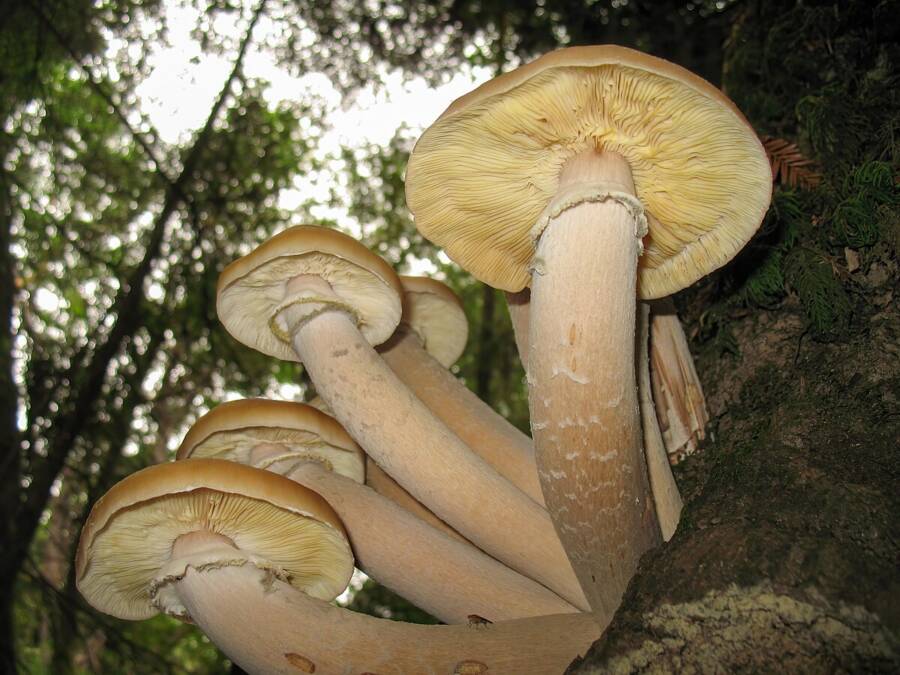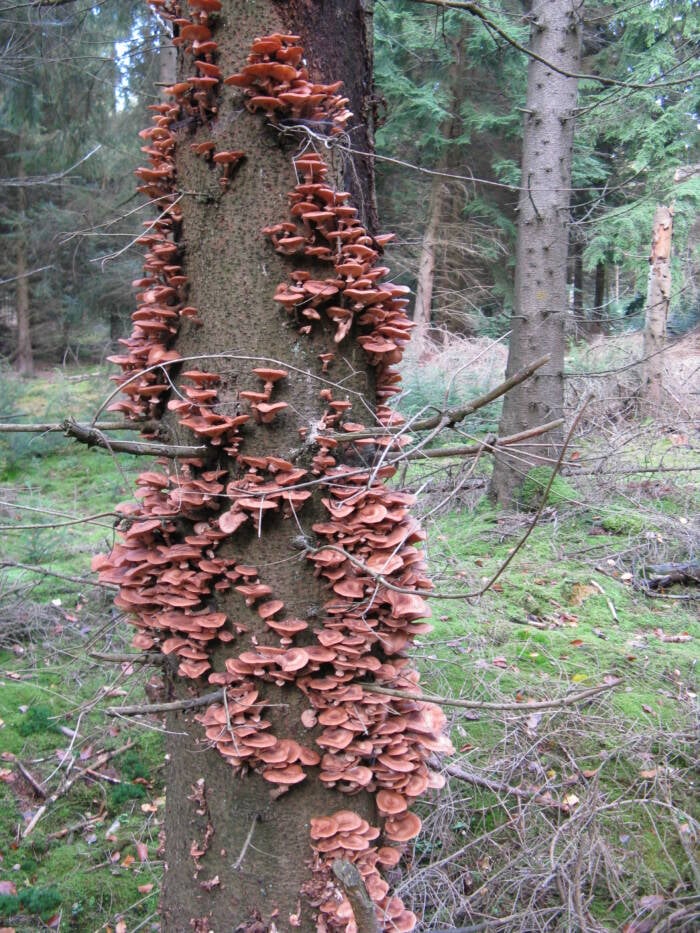The Humongous Fungus in Oregon's Malheur National Forest is 8,000 years old and covers an area of 2,000 acres, making it the largest living thing by area on planet Earth.

Wikimedia CommonsAn example of Armillaria ostoyae, the mushroom makes up the Humongous Fungus in Oregon.
Oregon’s Malheur National Forest is a beautiful place. And it’s also home to one of the most fascinating organisms on Earth, an enormous, sprawling species of Armillaria ostoyae which has been dubbed a “Humongous Fungus” because of its truly jaw-dropping size.
The A. ostoyae in Oregon, a species of fungus also known as honey mushrooms, is the largest single living organism by area on Earth. Not only does it cover thousands of acres, but it’s also believed to be 8,000 years old.
This is the incredible story of Oregon’s Humongous Fungus, the largest organism in the world.
The Discovery Of Oregon’s Humongous Fungus
The presence of Armillaria ostoyae was first detected at Malheur National Forest in 1988 by Greg Whipple of the Forest Service. Around the same time, a sprawling colony of Armillaria gallica was documented in Crystal Falls, Michigan. The Michigan fungus was so large that it was dubbed a “Humongous Fungus.” And when experts in Oregon took a look at their Armillaria ostoyae, they realized they had a “Humongous Fungus” too.

U.S. Forest ServiceA map of Armillaria ostoyae, the largest organism on Earth, in Malheur National Forest.
From the beginning, it was clear that Oregon’s Humongous Fungus was big — even bigger than Michigan’s. But as experts studied it, they realized that it was even bigger than they had thought. The Armillaria ostoyae colony was initially estimated to spread across 400 acres (Michigan’s Humongous Fungus spreads across 90) but genetic testing later revealed that it was one, single organism covering a sprawling 2,385 acres of forest.
The largest organism on earth, by area, and the largest mushroom in the world, Oregon’s Humongous Fungus is not only big, but heavy. It’s estimated to weigh up to 35,000 tons, or as much as 60 Boeing 747s.
So how did Oregon’s Humongous Fungus get so large? The answer lies in its age. Experts believe that it’s roughly 8,000 years old.
Despite its size and age, however, the world’s largest organism can be hard to spot. In Oregon, the Humongous Fungus only looks like typical honey mushrooms for a few weeks out of the year. Most of the time it looks like a webby, white substance when it grows above the ground, and sinewy black “shoestring” tendrils when it grows beneath the ground.

Debora Lyn Porter/University of UtahArmillaria ostoyae seen growing beneath the bark of an infected tree in Oregon.
A. ostoyae is mostly found in forests in British Columbia and the Pacific Northwest, though it has been documented in Asia and Europe as well. It’s certainly a curious and impressive organism. But the Humongous Fungus is also deadly to most species of trees.
How Armillaria Ostoyae Impacts The Environment
The largest organism in the world is so large because it mostly grows underground. And it grows underground so that it can feed on trees, slowly killing them over the course over several decades.
According to the Oregon Encyclopedia, the Humongous Fungus grows long, black filaments known as rhizomorphs which stretch out beneath the ground. They spread slowly — just 0.7 to 3.3 feet a year — but are deadly to the trees they encounter. The Humongous Fungus is a parasite eating the tree from the root, and will continue to feed on the tree even after it’s dead.

Debora Lyn Porter/University of UtahThe black rhizomorphs from Oregon’s Humongous Fungus that was gathered by researchers.
“[Trees are] girdled by the fungus,” Greg Filip, a pathologist with the U.S. Forest Service, told Oregon Public Broadcasting in 2015. “The fungus will grow all the way around the base of the tree and then kills all the tissues.”
Trees who have been infected by A. ostoyae have symptoms like resin flowing from their base, yellow or thinning crowns, white mycelial under their bark or — the tell-tale sign — honey mushrooms growing nearby in the autumn.
But Oregon’s Humongous Fungus doesn’t kill trees instantly. The process is a slowly, steady process that takes decades.
“It could be 20, 30, 50 years maybe before [the tree] finally dies,” Filip explained.

Dohduhdah/Wikimedia CommonsHoney mushrooms growing on a tree trunk.
As such, A. ostoyae can be considered an infestation, and it’s a frustrating problem for timber companies and farmers. But the fungus is extremely hard to eradicate. Only raking out every tendril of fungus can seemingly make a difference, something that most aren’t willing to do.
In any case, the Humongous Fungus does play an important role in an ecosystem’s natural cycle.
“There’s a wildlife benefit to these trees,” Filip explained. “Once they’re dead, they decay, the birds begin to excavate them and use them for cavities.”
And while the fungus is deadly, the world’s largest organism has many fans.
The Cultural Impact Of The World’s Largest Mushroom
The impact of the Humongous Fungus goes beyond the scientific community. The unique fungus has made a name for itself in larger popular culture – and in local chambers of commerce.
In Crystal Falls, Michigan, the home of the first Humongous Fungus, residents even throw a festival every year in honor of their own sprawling mushroom colony.

Humongous Fungus Fest/FacebookA scene from Michigan’s Humongous Fungus Fest, which takes place every summer in honor of their sprawling Armillaria colony.
Though Oregon is home to the largest mushroom in the world, it doesn’t have anything like that — so far. But the Oregon Humongous Fungus has made an impact in a different way. In 2012, author Richard Faulk named Malheur National Forest as one of his favorite “gross places” in America in his book Gross America, due to its Humongous Fungus.
“Don’t be fooled by an ordinary looking mushroom. Beneath it broods an ancient horror that has been growing quietly for thousands of years,” Faulk wrote.
Oregon’s Humongous Fungus has also captured the tourism market, with blog and tourism sites promoting the National Forest not just for its natural beauty, but strange large fungus. It was also featured in PBS’s Oregon Field Guide.
Indeed, the Oregon Humongous Fungus is an especially remarkable mushroom. The largest organism in the world, by area, it’s five times larger than the country of Monaco. But because the world’s biggest mushroom grows primarily underground, it can be hard to spot. Perhaps there are other, even larger, Humongous Funguses in the world.
For now, however, that crown belongs to Oregon.
After reading about Oregon’s Humongous Fungus, the largest organism on Earth and the biggest mushroom in the world, take a look at these 31 photos of colorful and cool mushroom species. Then, learn about these 9 weird fungi species.





